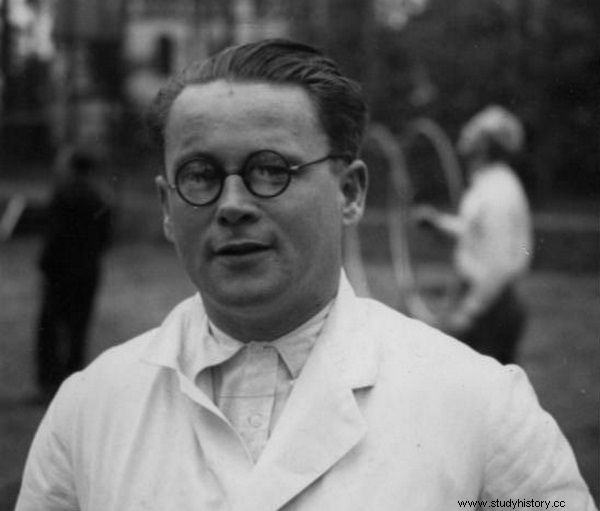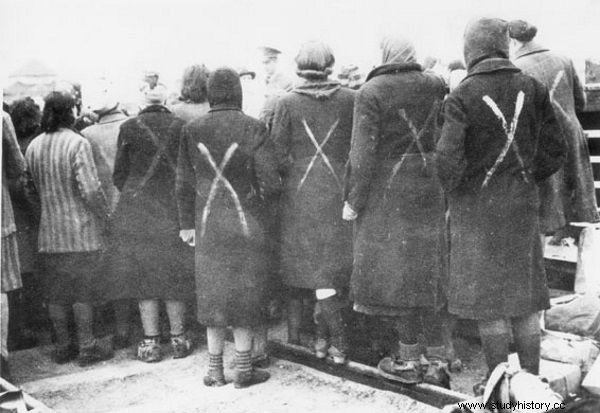It was a real testing ground for the Nazis. SS criminals trained here, doctors conducted murderous experiments, and prisoners died of exhaustion, forced to backbreaking labor. What did those who survived say about life in Ravensbrück?
"The atmosphere of the camp was terrible," said Zofia Czajkowska, a prisoner of Ravensbrück from August 1940 to April 1945, shortly after her release. "It caused memory loss, caused attacks of rage and frequent suicides by poisoning, hanging, cutting veins, throwing yourself on electrified wires or throwing yourself into the lake. ”
Czajkowska was one of over 130,000 women of 27 different nationalities who ended up in Ravensbrück. The first - mainly German women considered hostile to Nazism or "asocial" and German Jewish women - arrived there before the outbreak of the war, in May 1939. Soon after, Romki and Sinti joined them.
As time passed, the camp, initially intended for around 6,000 people, grew larger. Women from all the countries occupied by Hitler were sent there, including Polish women, whose largest transport - about 12,000 prisoners - arrived after the evacuation of Warsaw during the Warsaw Uprising. It was the moment of the greatest overcrowding - at the end of 1944, 36 thousand (according to some estimates, up to 50) thousand inmates were staying in Ravensbrück at the same time.
"We feel sorry for the ball"
From the very beginning of the existence of the criminal facility, the rigor imposed on women was almost unbearable. "The first female inhabitants of the camp suffered from discipline, brought to perfection, and excessively hard work, not the strength of women," says researcher Wanda Kiedrzyńska about the lives of female prisoners. "At that time, an additional torment was the functional, usually" black "or" green patches ", types with sadistic tendencies, against which there was no defense ”.

Initially, the camp was designed for 6,000 female prisoners, but it gradually grew.
The day in Ravensbrück started at 4 o'clock. After the "breakfast", which consisted of a cup of coffee, a roll-call took place, and then the prisoners, lined up in columns, marched to work. “The job lasted from 6 to 12; o 12 columns returned to the camp for dinner, some of them had to go to the camp and 4 km ”- recalls Czajkowska. The latter had literally a few minutes to eat lunch, because at 1 p.m. the sirens called for another working assembly. Women worked until 5 p.m. (later even 6 p.m.), and then often spent several hours on the evening roll call.
The activities they were entrusted with were often beyond their capacity. Inmates by their own efforts expanded the camp to accommodate new tenants. "Thousands, thousands of bricks, a chain from the lake had to be fed to the construction site" - reports Władysława Betlińska - "as if 200, 300 bricks had passed through the hands (...) the skin and blood were rubbed" . Women were also sent to work in nearby farms, armaments plants and factories - their services were used, among others, by the Siemens plant. As Czajkowska recounts:
Working in winter was extremely hard, because we were lightly dressed, we had no gloves, our hands and faces were cracked in the cold, which resulted in numerous third degree frostbite cases; I myself had my legs frostbitten to the wounds. In the summer we worked again in the heat in thick dresses, in heavy and uncomfortable shoes, without a bit of water. The authorities tried to destroy us under these harsh conditions, it was completely deliberate, the caretakers themselves said that we are sorry for the ball, the conditions alone will destroy us .
Starvation rations were also supposed to "help" to finish the prisoners. At the beginning of the camp's operation, it was half a liter of soup twice a day, sometimes with 3-4 potatoes, often rotten, and 250 grams of bread. Later - the more populated the camp became - the portions were gradually reduced. At the worst moment, the inhabitants of the camp received less than 900 calories a day. At this stage, the piece of bread they were getting weighed only 100 grams…

The article was inspired by the novel by Magda Knedler My friends from Ravensbrück , based on the testimonies of female prisoners, a story about a friendship that is stronger than the walls of the camp and stronger than the brutal strikes of the guards.
"They were all pretty girls"
The SS garrison under the leadership of the camp commandant, Max Koegel, supervised the efficient functioning of the camp and the course of work. As the central women's camp of the Third Reich, Ravensbrück was also a training center for the SS Aufseherinen, that is - as the prisoners used to say - "hooligans", SS-supervisors. Criminals such as Irma Grese, known as the "hyena from Auschwitz" or Hermine Braunsteiner - "the mare from Majdanek", started there.
"They were all very pretty girls, very shapely, the uniforms fit them beautifully" - recalls one of the former camp residents. Many inmates were shocked by the fact that other women exercise cruel power over them. But they found out the hard way that they couldn't expect any sympathy. Many of the rangers were real sadists, they seemed to take pleasure in intimidating their charges, whipping them, and chewing wolfhounds on them, which - trained to bite on orders - helped keep order .
The dressers and functionaries recruited from the group of prisoners imposed severe penalties on the charges for the slightest offense. The most common ones were pouring buckets of cold water, beating, scrubbing blood with a rice brush or beating the head against the wall.
For larger "crimes" one could end up in a bunker - a brick building in which the camp prison was located. There, prisoners were often subjected to torture:"wolf's feet" piercing the body, a beating goat, shackles, and even "a kind of coffin with small holes for air in" were used.

Over 130,000 women prisoners passed through Ravensbrück, including 30,000–40,000 Polish women. One of the Polish prisoners in the photo.
"All the babies died"
Still, able-bodied women could speak of happiness anyway. Those exiled, which due to their condition, were removed from the list of potentially “profitable” workers were in the worst situation. This was the case with the insane who were sent to the camp in connection with the plan to "cleanse" the Third Reich. As a former prisoner, Gertrude Maron, tells:
Block 10 was the terror of the entire camp. There was a ward for the mentally ill. The sick were treated like animals. Almost without clothes, beaten to the blood - howl of hunger and thirst day and night . The selection car most often stopped by the ten. Only then did you see the full horror of treating the sick.
These poor victims, even on the way to the "fireplace", could not take their rags, they were torn off before the car and loaded into the depths with a simple kick. Then even one of the very strict Aufseherek wept. I've seen it.
Children also fell victim to the brutal conditions. In the period when the camp was at its peak, as many as 4–5 of them were born daily. Zofia Czajkowska recalls:
In 1940, 8 months pregnant women were released. In 1941, mothers gave birth in the district [the camp hospital - editor's note A.W.] , but the children were killed, and Dr. Rosenthal himself carried the bodies of the newborns to the boiler room. There was a period when all newcomers were examined gynecologically and the pregnant women were also induced an artificial miscarriage. In 1944, newborns were not killed at birth, but almost all died out, unable to pass the harsh conditions of the camp.

Dr. Karl Gebhardt led the experiments.
This terrible account is confirmed by Gertruda Maron, who worked in block 11 for mothers and babies. She says that there were many children of women transported to the camp from occupied Warsaw. They had minimal chance of survival. They were not bathed, so they quickly developed skin diseases. They also developed pneumonia when they were carried through the cold corridor to nursing mothers. As Maron emphasizes, it was a planned action by the camp staff:
All infants died 1-2 weeks after birth. (...) the German sisters were instructed not to interfere with the sickness and death of infants. Therefore, they were not taken care of absolutely - they were doomed to extinction. The babies were left unattended overnight. In the morning, they were found mercilessly bitten by worms and rats.
"Kings"
Due to the fact that many women were sent to Ravensbrück with death sentences, the camp staff, starting in the summer of 1942, decided to conduct medical experiments on them. They were led by Dr. Karl Gebhardt, who was assisted by other doctors from the district. At least several dozen people were subjected to experimental operations. Healthy prisoners were selected, mainly Polish.
First of all, methods of treating "frontal" wounds to which German soldiers were exposed were tested. The operated bones were broken, tendons were removed, and pieces of metal were left in their bodies. They were also injected with the germs of tetanus, gas gangrene, malignant edema and others. The conditions for carrying out these operations were inhumane. As Zofia Mączka recalls, a doctor who was sent to the camp in September 1941:
Dressings were made according to the willingness of prescribing doctors in the hospital, with dirty tools, unsterilized compresses, and if Dr. Rosenthal was dressing, he used methods of inhuman abuse of the victims, ripped wounds with tools, took off sadistically, half-drunk or completely drunk while flirting with his assistant Gerda Quernheim. The results of the operation were uncontrolled and the patient's condition was not studied ...

The article was inspired by the novel by Magda Knedler My friends from Ravensbrück , based on the testimonies of female prisoners, a story about a friendship that is stronger than the walls of the camp and stronger than the brutal strikes of the guards.
Polish women were operated several times. Everything was against their will. They were ostensibly summoned for questioning and then overpowered. They woke up the next day with extensive wounds. Those tested for infections were in the worst condition. "In the room where the sick were lying with wounds infected for the experiment or infected by sloppy doctors - there was a smell that was equal only to that of decaying corpses" - says the prisoner Zofia Sokulska.
"Ich bin inc kein Kanninchen!" ("I'm not a rabbit!") - Wanda Półtawska told one of the camp doctors after such an operation. The staff of the district picked up on this term and began to refer to women as "rabbits." They themselves - the survivors - still call themselves “kings”.
Balance of wrongs
Ravensbrück's death toll is estimated at around 50,000. Many women died of hunger and disease, others were killed, initially with a shot to the head, and from November 1944 - sent to a gas chamber built near the camp. Some were sent to their deaths onwards, to Auschwitz and other camps.

At the end of April 1945, several hundred women prisoners were handed over to the Red Cross.
During the six years of the camp's existence, only a few managed to escape. The first attempt was made in 1940 by a prisoner named Weiss, but she was quickly caught. As a punishment, she was handed over to the court of other inmates, held at the roll call for as long as she was searched for. The rangers waited half an hour… and collected her body from the square . Eugenia Kocwa, who escaped in May 1944, was more fortunate - she took advantage of the chaos caused by overpopulation in Ravensbrück.
The camp was evacuated in April 1945 when the Red Army was approaching it. At the end of that month, several hundred women prisoners were handed over to the Red Cross. 24,500 women started the death march. At the time of liberation - April 30, 1945 - there were only 3,500 forced tenants in women's hell.
Inspiration:
The article was inspired by the novel by Magda Knedler My friends from Ravensbr ück , inspired by testimonies of female prisoners, a story about a friendship that is stronger than the walls of the camp and stronger than the brutal strikes of the guards.
Check where to buy "My friends from Ravensbrück":
